I don’t remember why I watched the pilot episode that came on one night after dinner in 1974: in those days before our family had a remote it was sometimes a passive decision, simply easier to keep watching in the stuffed chair than cross the room and turn the dial. But great discoveries can come from laziness, and so after seeing an old vagrant ride a city bus to the end of the line and get strangled by a weightlifter under Santa Monica Pier, the story moved to an L.A. bikini shop, where a handsome sideburned man was reluctantly agreeing to investigate the death for the victim’s daughter (Lindsay Wagner) as she dressed a mannequin.
The first show did not reek of tough-guy promise. First of all, he turned down the job he was hired for not once but twice, and except for his California P.I. license he seemed like just another big affable guy with ordinary problems: an understocked fridge, people hectoring him through his answering machine. His concerns seemed unheroic and, perhaps worst of all, he did not even carry a gun, keeping one only for emergencies in a cookie jar in the kitchen of his house trailer. And when at one point his client asked, a little concerned, “You’re not afraid of him, are you?” he told her the truth, “You’re damn right I am.”
But what grabbed me from the first episode was one hilarious scene: Jim Rockford, tired of being trailed by the vagrant’s muscular killer (William Smith) in a long red convertible, pulls into the Mayfair Music Hall, a Santa Monica venue of vaudeville-era entertainments. The bow-tied bartender greets Rockford and asks “The usual?” as a young woman performs a slow split atop a wire, meaning Jim either comes here often to lose a tail or he likes novelty acts. After his brawny pursuer enters the bar and growls his drink order, Jim heads to the men’s room to prepare his trap. The Mayfair switches to a troupe of dancing poodles as Rockford’s man stalks to the bathroom, where Jim has drizzled hand soap across the floor and retrieved a roll of nickels from his coat pocket, taunting, “You musclebound guys are always overcompensating.” The charge of latency draws a macho scream and a high kick that slides him back onto the soapy tile, where Jim lands a cheap insurance shot. According to Ed Robertson’s history of The Rockford Files, this scene nearly broke the ASI meter when the pilot was tested, and may have made the show. It did for me. By cheating a little, it seemed a clever man could take down a bully. I was hooked.
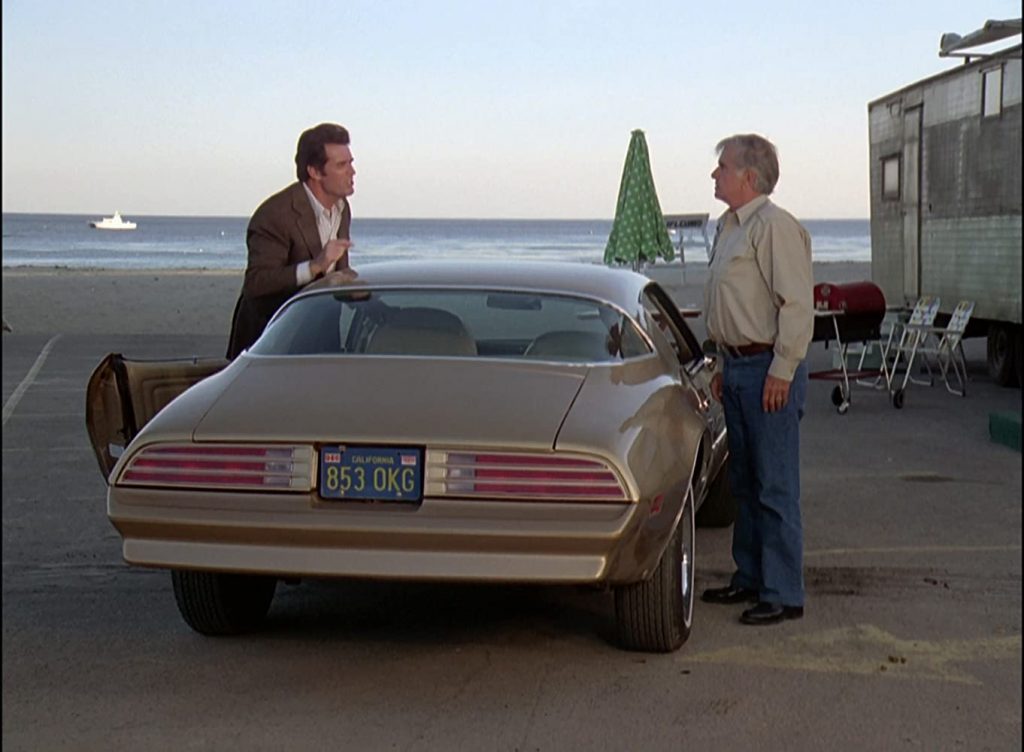
To an eleven-year-old, Jim Rockford had a life I could happily imagine for my future self: He lived alone in a beaten green and white trailer on a promontory over a Malibu beach, where he spent much of his free time surfcasting, often with his dad, a semi-retired longhaul trucker known as Rocky, whose whole existence seemed to revolve around fishing with his adult son; when he worked, Jim Rockford charged clients an impressive-sounding “$200 a day plus expenses” for snooping around and he drove a cool gold Pontiac Firebird Esprit in which he outmaneuvered Mob wheelmen and hot-headed Feds. (The car chase thrived on 1970s TV the way the epic guitar solo dominated ‘70s rock.)
Over five and a half seasons, Jim Rockford would offer a number of life lessons: That you can gain entry to many social functions simply by wearing a blue sport coat or phony glasses; when impersonating salesmen, it’s good to have a variety of drawling accents and bold hats; any business office can be accessed either with a set of quality lock picks or by double-talking the receptionist and showing fake business cards you can print in your car; in a high-speed chase, you can often outsmart goons with a cool reverse J-turn move they somehow never expect; sometimes you’ll work for people you detest, so know how much you’re willing to take; likewise, being a good listener is not only nice manners but also can be professionally useful. And finally, if you want the dream of a home office without paying a secretary, then rent an answering machine (rather new at the time).
The Rockford Files’ opening sequence did not show the usual action shot, chalk corpse silhouette, or hero swirled in police lights but a pan of Jim’s untidy desk laid with playing cards and a large standing photo of his dad, as the answering machine plays. Jim’s messages famously began every episode, ensuring that fans of the show would be in their seats as it opened: “Hey Jim, this is Louie down at the fish market—you gonna pick up these halibut or what?”
Jim’s style may be sardonic, but he can be decent to a fault, rare among world-weary sleuths, perhaps because his father Rocky believes the best of people. Rocky was appealingly played by Noah Beery, with his can-do 1940s cowboy demeanor. (If you have seen Red River he is part of the montage of cowhand faces howling to launch the famous cattle drive). Rocky is always telling his son to drive a rig (it’s safer) or come up to the cabin to hunt and relax from the hazards of the investigator’s life. Writer Stephen Cannell created Rocky thinking of his own father, who was puzzled by his strange choice of profession instead of joining the family business. There is scant evidence in the show that Jim ever had a mother; perhaps it would be too painful to talk about.
Rocky hopes Jim will get married and find a less dangerous line of work, but always helps him out when goons come to the trailer, which is often. (Rockford’s trailer may be the most-tossed location in TV history.) After one close call, however, Rocky finally blows up: “I am through talking to you! Look at you, an inch or two to the right and you’d be missing that eye!”
“Yeah,” answers Jim, “but look at it this way, an inch or two to the left and he’d have missed me completely.” Rocky is not amused.
It is hard now to appreciate the freshness of Jim Rockford’s adventures against its era of old school police dramas and newer crime shows with smirky tag lines.
The Rockford Files seemed revolutionary in being so funny and still delivering a tense crime plot. It is hard now to appreciate the freshness of Jim Rockford’s adventures against its era of old school police dramas and newer crime shows with smirky tag lines (Kojak’s “Who loves Ya, baby?’ or Baretta’s “And dat’s the name of dat tune”): One of the funnier Rockford episodes, “A Clean Bust with Sequel Rights,” spoofs such shows, when Jim is hired by an insurance company to “babysit” a celebrity cop (Hector Elizondo) whose police exploits have become a bestseller, movie, TV show and kids’ toy line. It pains Jim how his father is thrilled watching the TV detective shout, “Freeze, Turkey!” as he makes the bust. (In fact, Rockford Files began as an unused plot idea for another project of producer Roy Huggins, the short-lived Detective series Toma, which itself then morphed into Robert Blake’s Baretta.)
Jim had none of the hard-drinking tough guy detective who needs to be saved from himself and he would not be caught walking around with Baretta’s cockatoo on his shoulder, either. In the second season (“The Big Ripoff,” Ep7) we get as close as we come to a Rockford code: Jill Clayburgh plays a young artist’s model who rescues Jim after he’s been badly beaten up. As he returns to his dangerous work, she asks, “Is there any thing you won’t do for money?” “I won’t kill for it,” Rockford answers, “and I won’t marry for it. Other than that, I’m open to just about anything.” At the time The Rockford Files appeared, the closest thing to it was Harry O, whose private eye worked on his boat when not solving crimes. But Harry retained the gravitas of the police detective he once had been; Rockford’s sense of justice comes from his serving five years for a robbery he didn’t commit, before receiving a pardon and learning to become a PI. Still, I’m sure the ex-cop and ex-con could have gone fishing together in Harry’s boat.
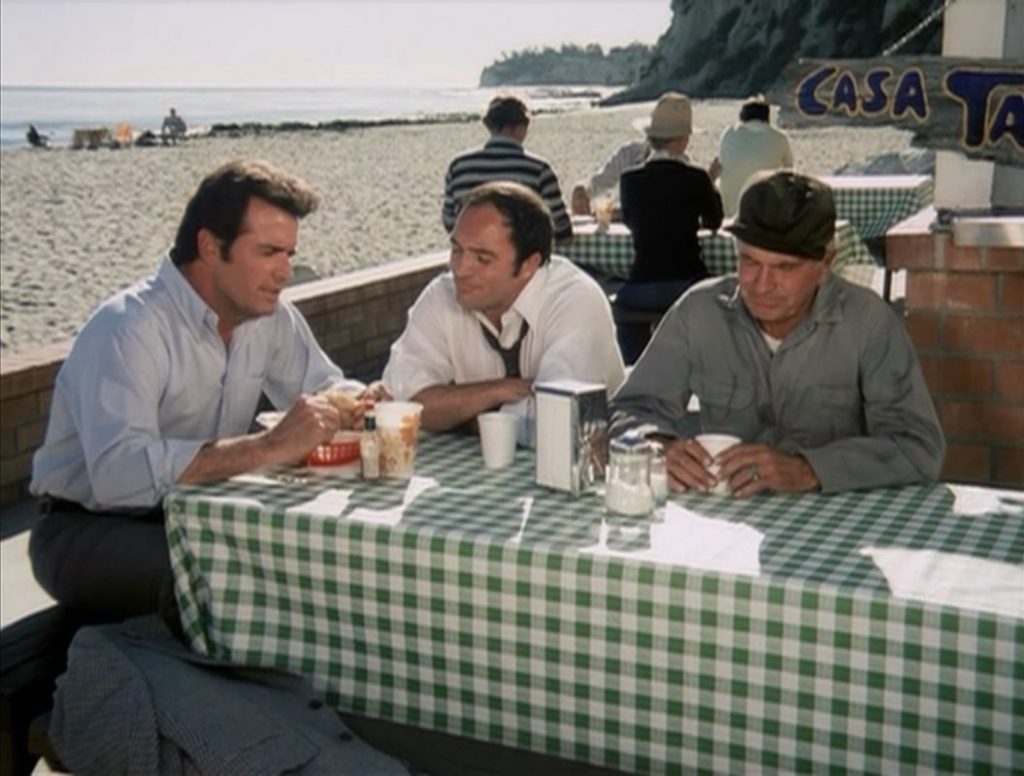
Now, when many TV investigators have a drug habit, a debilitating phobia or a splattery past as a serial killer, it is hard to take seriously the “anti-hero” packaging that accompanied these Rockford episodes. But he was, in the same way as James Garner’s earlier character Bret Maverick stood apart from the stolid lawmen and bold gunfighters of the Westerns that crowded the late 1950s TV schedule. Maverick, its creator maintained, was a show in which the situation was often hopeless but never serious. The Rockford innovation was really a renewal of Bret Maverick’s sly pose in a new setting. Garner, an Oklahoman of part-Cherokee heritage (his production company was Cherokee Productions), had joined the Merchant Marine as a teenager in World War II and later received two Purple Hearts for his service in Korea, yet made a convincing leading man reluctant to go to war, most famously with Julie Andrews in The Americanization of Emily.
The self-interested hero was charmingly done on Maverick, where Bret toured Western towns and river boat cities in search of poker and brief romance and usually found danger besides. Maverick was a departure from the glut of TV Westerns; he was neither noble nor icy veined, and not disposed to gunplay yet capable if trapped by frontier circumstances. His storylines did not teach a hokey lesson about Americanism; he was mostly concerned for himself, trying to survive on his card skill and wits.
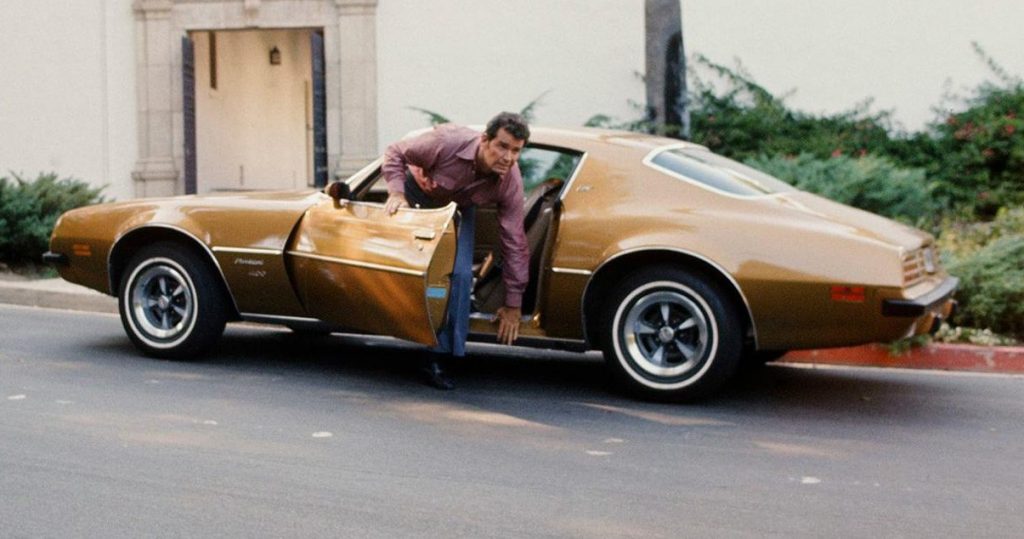
When a similar craze for private eye shows overtook the networks almost twenty years after Maverick, James Rockford appeared, with a similar take on life, though considerably less cardplay, as a perfect character for Garner. Like Maverick, Jim Rockford seeks no trouble, freely admits fear and turns down work as too dangerous, but if cornered, he can handle himself. (Others have noted that he unstoically shakes out his hand after using his fist.) Executive Producer Roy Huggins, who had originally created Maverick as well as The Fugitive, now retooled a number of storylines for an updated setting, while writer Stephen Cannell, who had been a great fan of Maverick, had Huggins’s permission to borrow its plots and spirit for Jim Rockford.
* * *
Rockford’s being an ex-con allowed the writers a secondary cast of colorful guest spots and returning characters emerging from San Quentin, from Isaac Hayes to Eddie Fontaine to Stuart Margolin. (More on Isaac Hayes—and the spinoff series that should have happened—below.) Rockford never entirely dismisses his criminal acquaintances, even those who beat him up when they served together. He is also (like Garner himself) a Korean vet, which allows Ned Beatty or Ken Swofford to reenter his life citing war buddy favors owed. Even Jim’s one-time parole officer is on the make. Of all the characters, though, from Rob Reiner guesting as a sleazy minor quarterback to Claudette Nevins as an anti-feminist author, it is Rockford’s old cellmate, ‘Angel’ Martin who is the most entertaining, appearing in almost a third of the episodes.
The Rockford Files is at its funniest whenever the nervous Angel shows up to complicate Jim’s life. (“Jim Buddy-buddy,” one Rockford phone message begins, “You know how they allow you one phone call? Well, this is it. Hello? Hello?”). Angel is your needy grifter friend who always disappoints. (Find out why Angel deserved his own spinoff below.)
The Rockford Files mostly predates the era of season arcs, except for occasional two-part stories, so there are various methods for choosing where to start watching, if you missed it originally. You can binge straight through its 118 episodes, or begin with those in which ‘Angel’ appears; or watch every one written by co-producer David Chase (later of The Sopranos), who even then steered plots back toward the Jersey mob; or see any episode in which Rockford is comically paired with a rival P.I. such as Tom Selleck (as the impeccable Lance White). Rockford’s frustration with people and events is one of the show’s many pleasures. His crucial friendship with Sgt. Dennis Becker brings Jim regularly into his least favorite setting, the police station house, where he is tolerated at best, and sometimes briefly arrested.
For a 1970s detective, Jim Rockford has impressively few cringey moments with the show’s female guests, a series of vivid and believable women often created by writer-producer Juanita Bartlett. With women, Rockford is a courtly good listener who happens to live in a trailer. We are told that he used to date his lawyer, Beth (Gretchen Corbett) and the writers occasionally break Jim’s heart with a disappearing fiancée or a blind psychologist girlfriend who dumps him. (Rita Moreno won an Emmy portraying a prostitute and police informant whom Jim helps.) Old flames (Susan Strasberg or Valerie Pointer) return mainly when they want him to fix something in their lives or to set him up as the fall guy delivering a briefcase. He loyally complies, and often regrets it.
Many shows have been influenced by The Rockford Files or have sought to strike its balance of elements—but you need the writing and you need James Garner, and nobody has had both. Recently, Republic of Doyle, a CBC show about a father-and-son detective agency in Newfoundland, claimed to be inspired by it, but there isn’t a strong resemblance. There may be something Rockfordesque in some of the manly banter on True Detective, but its overall mission is much darker.
Many shows have been influenced by The Rockford Files or have sought to strike its balance of elements—but you need the writing and you need James Garner.
Guy Pearce’s superb series for Australian TV, Jack Irish, (based on the Peter Temple novels) comes closest to the mark. It has some of the wit and offbeat spirit, especially the splendid character writing, with a grumbling assortment of old bar types and marvelous racing touts. Jack is a compelling stubbled presence with rich side hobbies, and something about a scene when he gets beat up and then peed on by gunless Aussie thugs seemed particularly evocative of The Rockford Files. But Jack does have his morose drinking bouts, another investigator with demons. (His troubled late father, it seems, was no Rocky.)
Jim Rockford may feel bad or overly responsible about events in his life, but he seldom feels openly sorry for himself; Rocky wouldn’t have it. It’s also easier to clear your head where he lives. Jim recovers from the tragedies in his work with a walk down the beach, or a fast drive along the coast in his Firebird, then he’s back home to find his tackle. So he beats on, casting into the surf until the next stranger pulls up, pauses a skeptical beat before his trailer door, and knocks with a new case. I’m expensive, Jim will explain inside, brushing off a space to sit.
___________________________________
Favorite Episodes
___________________________________

There are definite worsts, but far too many great episodes to select a simple best list. So I have a sampler of some favorites as well as a strongest season (Season 3). Also, since 1970s L.A. is his scruffy co-star, I am less fond of episodes set out of town (in Hawaii, Denver, Seattle, or Vegas), basically anytime Jim is deprived of his real car.
Stings and Counter-stings: Some favorites tend to be plots in which Jim organizes ambitious revenge cons inspired by The Sting: In “There’s One in Every Port,” (Season 3, Ep 12) he pulls off the textbook Big Con against a father-daughter team of maritime scammers. “Counter Gambit” (Season 1, Episode 16) is a wonderful revenge scam in which Jim is first hired by ex-cons allegedly to find a missing girlfriend, but they are secretly just after her pearl necklace, which they intend to steal and blame on Rockford. The one priceless scene comes when Angel is forced to substitute as the terrified appraiser for the criminals’ jewels.
Multiple PIs: The show’s writers loved detectives, but even more when they could contrive detective stories within detective stories, such as “Nice Guys Finish Dead” (Season 6, Ep 7). It begins with a PI convention where Jim is up for an unlikely but well-deserved award, nominated by PI Lance White (Tom Selleck, before his Magnum days). Jim’s moment is spoiled by a murder in the Men’s room, forcing private eyes who can’t stand or trust each other to band together for the solution. White (Selleck) does everything handsomely wrong and still succeeds, to Jim’s increasing annoyance. Similarly, in “Sitcks and Stones May Break Your Bones, but Waterbury will Bury You” (Season 3, Ep 13), a Pinkerton-like big agency is killing off the region’s little PIs (including guest star Cleavon Little) for their turf, and the remaining independents must band together to uncover the plot.
“The House on Willis Avenue” (Season 4, Ep 21), an epic two-parter, starts at the funeral of an old private eye who was Rockford’s mentor learning the business; at the service, Jim meets a much younger detective who shared this same teacher and finds the circumstances of his death curious: the pair uncover a strange criminal network of computers run by still another detective (Jackie Cooper). This story ends with a prescient onscreen warning about the national threat posed by “Secret information centers, building dossiers on individuals…”
Homefront: In “Paradise Cove” (Season 6, Ep 1), Jim has to defend his home on two fronts: enduring the simultaneous challenge of a court-appointed receiver’s inventory of his possessions to pay a lawsuit settlement against him, and a threat from a member of his Paradise Cove Homeowners’ Association, who secretly wants the gold bullion that may or may not be hidden beneath Rockford’s trailer from a long-ago heist. Mariette Hartley, who was already selling Polaroid cameras in a series of charming TV ads with Garner, guests as his court-appointed creditor who becomes gradually interested in the intrigue off the books. (Hartley was asked so often about her apparent TV marriage to him that she had a T-shirt printed, I’m not Mrs. James Garner.) This episode, which opened the final season, has a funny premise: Likable as he is, what homeowners’ group would want Jim Rockford living among them, with his frequent violent visits from goons? It is worth it for Angel’s Treasure of the Sierra Madre speech alone, when he thinks the gold will be theirs.
___________________________________
City of ‘Angel’
___________________________________
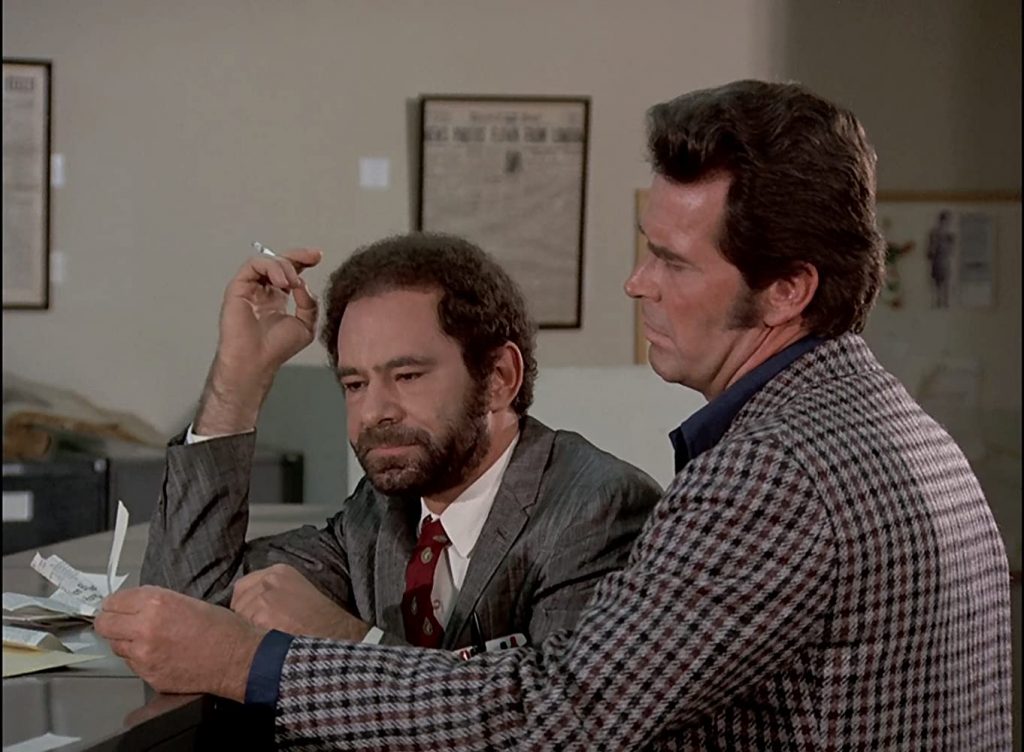
In a later time of Better Call Saul or Curb Your Enthusiasm, in which character is destiny and comic, self-sabotaging flaws drive the drama, Evelyn ‘Angel’ Martin would have enjoyed his own spinoff series. Unsuccessful as both a squealer and small-time con man, each week Angel could overplay his hand in a different scheme that collapses. (Before taking the Angel role, Stuart Margolin had appeared with Garner on the brief-lived TV Western, Nichols.)
You can construct your own series—call it City of ‘Angel’—out of the 37 episodes graced by his manic presence. Angel’s escalating lies are sort of the point, and the failure of each con, like the building of a classic comedy gag, is as funny as it is anticipated. (Garner himself later confessed he had no idea why the two characters were still friends, but it amused the rest of us.) “Jimmy, I had to stay alive,” Angel explains some latest betrayal. “You’re alive,” Rockford concedes. “You have plenty of good years left for sniveling and complaining.”
In one episode, he forges papers to sell someone a horse that “could” be “Secretariat’s long-lost son” (“a grey area,” he concedes to Jim); in another, (“Rattlers Class of ’63”) Angel asks Jim to be his best man an hour before a wedding that turns out to stem from a botched grift. “It’s a variation on the Red Barn con,” he confesses after the ceremony turns into a brawl with the bride’s family. “Then why,” Rockford reasonably asks, “did you marry the mark’s sister?”
In “Drought at Indian Head River,” (Season 3, Ep 13) Angel is suddenly rolling in money as an unwitting front in a mob real estate scam controlled by Robert Loggia. When Jim visits Angel’s new penthouse to warn him that he is about to be killed, Angel cuts him off: “I go by ‘Angelo’ now. ‘Angel’ is not an important name.” In another story, Angel becomes a material witness needing police protection, insists the cops serve him his meals in his motel bed, and decides the time has come to dictate his memoirs. And in “Dog and Pony Show” (Season 4, Ep 5) Angel again gets Jim arrested along with him, and a judge decides they both need to attend group therapy. In the sessions, Angel spins a long tale about his mythical family and work for the CIA (“I’m just glad the Agency didn’t find out about my gun running days because of all this. I can’t say anything more.”).
It hit the news this past winter that some websites were advertising murders for hire but keeping the Bitcoin without following through on the killing part. I remembered Angel’s similar (but flawed) scheme of advertising as a hit man and keeping the client’s money after the face-to-face handoff. “Jimmy, you got to help me,” Angel begs when his own life is threatened. The trouble with Angel is he doesn’t stay helped.
A show based on Angel and his imploding cons would find an easy home today.
When The Rockford Files staged a brief return in the early ’90s it showed Angel failing as a looter in the L.A. riots (sadly choosing to cover his head with a clear plastic bag that left him recognizable to Police choppers). According to Ed Robertson, the gag was the idea of Stuart Margolin, who had won two Emmys playing Angel and knew him better than anyone.
___________________________________
Gabby & Gandy, The Show that Could Have Been
___________________________________
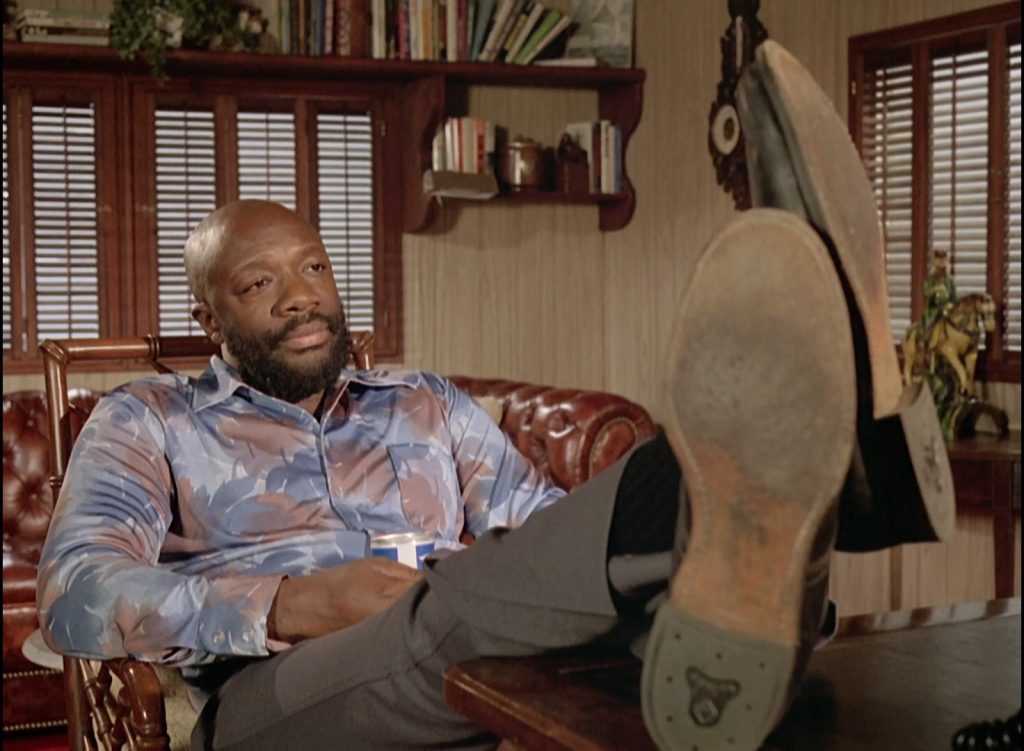
I loved the original Spenser for Hire, but have always wanted to see a crime show where the white guy is the strong-arm sidekick, the Hawk role. In 1977, the makers of The Rockford Files tried to go one better: using a Rockford episode (“Just Another Polish Wedding,” Season 3, Ep 17) as a possible network spinoff about its two guests—black investigators played by Louis Gossett, Jr. and Isaac Hayes, at the height of his post-Shaft cool.
Each character had appeared previously on Rockford, one as Jim’s former parole officer, Marcus Aurelius “Gabby” Hayes (Gossett) who has become a high-end PI who hones his refined image by driving around in a Rolls Royce on an extended test drive; the other is Gandy Fitch (Isaac Hayes), a short-fused ex-con Jim knew to avoid at San Quentin. In a previous episode (“The Hammer of C Block,” Season 3) Rockford helped Gandy clear himself of the crime for which he had served 20 years.
When Gandy looks up “Rockfish” again in this spinoff episode, broke, and insists on working as Jim’s muscle, Rockford arranges a lunch and tries to unload him on Marcus Hayes, his old parole officer turned slick investigator, who sticks Jim with the price of the meal, then tries to steal Rockford’s current case, offering to cut Gandy in on the finder’s fee.
This episode has a lot to recommend it, but is famous for a scene where the pair blunders into a meeting of Neo-Nazis in a Los Angeles bar; polka music plays as members shoot pool and swig beer in full uniform. The cues are swinging soon after the black strangers enter, and Hayes (Gossett) grabs the bartender’s sawed-off shotgun and blows away the framed Hitler portrait. The pair make righteous work of the jackboots, then Hayes delivers a critique worthy of our time: “So, these are the rough, tough right wing National Socialists we keep hearing about.” As police sirens wail louder outside he lectures his bruised audience on the strength and virtue of the American middle class before Gandy can drag him away. “I think that went well,” he gloats, safely in the backseat. “Yeah,” Gandy admits, “you were cookin’.” A partnership is born.
At a time when black actors on crime dramas often played pimps, streetwalkers, drug dealers, or addict-informants, this attempt at a spinoff series with two black detectives was ambitious. That “Gabby & Gandy” was not picked up is disappointing but not to be blamed on its era alone. No network program like it followed. Isaac Hayes would return (solo) to The Rockford Files as Gandy the following season (in “Second Chance,” Season 4, Ep 4), asking Jim’s help to protect the life of his current girlfriend, played by Dionne Warwick, whose songs Hayes covered so soulfully.
___________________________________
The Rockford Philes
___________________________________
It turns out that there are still quite a number of us who, anticipating a situation where we might feel a little imposterish, reach for the dark sports jacket as Jim would do. Here are some ways to celebrate, discuss, and even learn more about The Rockford Files.
Watching: The Rockford Files is distributed by IMDB, for free with ads, on the IMDB site and also streams through Amazon Prime. Its superb progenitor, Maverick is available for purchase through Amazon, YouTube, and ITunes. Rockford Files is also available (with the 1990s TV movies) in a 22-DVD boxed set, The Rockford Files: The Complete Series (Mill Creek Entertainment).
Books: 30 Years of The Rockford Files by Ed Robertson (ASJA Pr., 2005) or Robertson’s earlier ‘This is Jim Rockford’: The Rockford Files (20th anniversary Tribute, Pomegranate Press, 1995). Robertson did many interviews with the show’s principals, and presents a good history of the program’s evolution as well as synopses of all the episodes. For more stories about the making of Maverick and Rockford see The Garner Files: A Memoir by Jon Winokur and James Garner (S&S, 2012), and an earlier fan’s book, The Rockford Phile: The Unofficial Casebook of the Rockford Files by David Martindale (Pioneer Books, 1991).
Podcasts: Tribute books are nice, but if you really want to disappear down an entertaining rabbit hole filled with pieces of the world of 29 Cove Rd., this podcast can be pretty fun. Run by two young gamers who found the show decades after its network reign, in some ways their project resembles paleontologists studying the lost age when long, high-powered vehicles roamed the Earth in California car chases.
Creators Nathan D. Paoletta and Epidiah Ravachol have appropriately named their forum Two Hundred a Day: A Rockford Files Podcast, and on it they discuss every episode’s plot and craft and the intellectual predilections of its writers, while offering their own accompanying detective-style notes, presented in spreadsheet form: the make of every evocative PGC (Primary Goon Car) is catalogued, from a goonish green and white 1973 Dodge Charger to a red and white 1975 Lincoln Continental, whether involved in an episode car chase or just a sinister visit to the trailer to grab Jim or toss his place. Also, you’ll find running tallies of each of Jim’s beloved taco lunches, those of his expenses left unreiumbursed, and plot points like: “Dennis can’t wash his ham-and-cheese sandwich down because the station coffee is bad.” Classic Brooklyn-curmudgeonly Dennis! Pick your favorite episode under discussion and see if you agree. (Apple Podcasts)

















